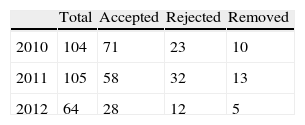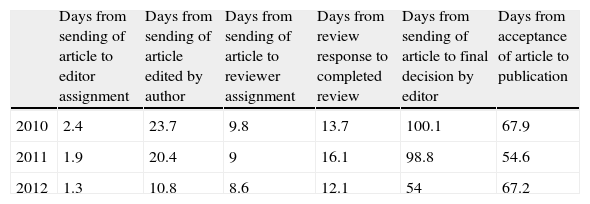In the editorial included in issue 6 of volume 54 (RECOT. 2010;54(6):343) we expressed the objectives of the editorial committee appointed by the managing board of SECOT earlier that year. One year later (RECOT. 2011;55(6):419), we conducted an analysis of that first year.
We believe it appropriate to conduct a new review of the operation of the journal in this period. We have selected the works included between issue 5, 2010 and issue 6, 2012, in order to reflect the history of the current editing team. In those 14 instalments, which have each had 81 pages on an average, we have published 13 editorials, 79 original clinical and research articles, 37 case reports, 22 update topics, 9 training works, 5 letters to the editor and 5 book reviews (Fig. 1).
The time periods of the editorial process, number of manuscripts received, acceptance rate, etc., can be seen in the following tables provided by the Elsevier production team (Tables 1–3, as well as Figs. 2–4).
Editorial times.
| Days from sending of article to editor assignment | Days from sending of article edited by author | Days from sending of article to reviewer assignment | Days from review response to completed review | Days from sending of article to final decision by editor | Days from acceptance of article to publication | |
| 2010 | 2.4 | 23.7 | 9.8 | 13.7 | 100.1 | 67.9 |
| 2011 | 1.9 | 20.4 | 9 | 16.1 | 98.8 | 54.6 |
| 2012 | 1.3 | 10.8 | 8.6 | 12.1 | 54 | 67.2 |
The rejection rate was around 30%, although there are currently numerous manuscripts in production so this rate may vary by the end of 2012 (this editorial is being written in early October). Our production times are comparable to those of any international journal. In other words, a little more than 3 months (100 days) elapse from the time of arrival of a manuscript until the final decision, which often includes 1 or 2 reviews by the authors. This reflects a considerable effort on the part of authors, reviewers and publishing staff (editorial, administrative and production team).
Regarding the topics that have been covered by the mentioned manuscripts, we can see that they have included all aspects of the specialty, as befits a general Journal of Orthopaedics and Traumatology (Fig. 5).
Out of all this material, 71 works out of the total 170 (41%) were elaborated collaboratively by various centres.
As for the geographical origin of the work centres of the authors, the regional distribution is reflected in the following graphs (Figs. 6–8).
Regarding contributions from other countries, the most noteworthy are Chile (3 original articles and 2 case reports), Portugal (2 original articles and 1 case report), Morocco and France. Other centres in the United States, United Kingdom and France have contributed update topics.
Over 30 national centres without a direct university link have had manuscripts published, which has greater merit considering their reduced infrastructure, at least theoretically. However, works from regional and nationwide reference centres have been missed, despite repeated requests by the editorial team of the journal and the president of SECOT.
But, have we reached our goal? From the editorial standpoint, we consider that we have met deadlines and published issues regularly, even though occasionally we have had to speed up the process and request contributions at the last minute. However, in order for this editorial comment to be published in January, it must be processed in early October. Therefore, as noted previously, we do not know if we have achieved “the goal”. During the month of October the journal will have been re-evaluated by the relevant committee from the National Library of Medicine and the result of that process, its inclusion or not within international indices, will mark the future not just of the management team, which is scarcely relevant, but of the journal itself, which may need to redesign its strategy depending on the outcome: a positive result will lead to a brighter future, in which having an impact factor will facilitate the arrival of more and higher quality material. On the other hand, a negative result may require a radical change of strategy…. By the time these lines are available to our readers, this question will have been answered.
Please cite this article as: Gil Garay E. Autoevaluación. Rev Esp Cir Ortop Traumatol. 2013;57:1–4.
























